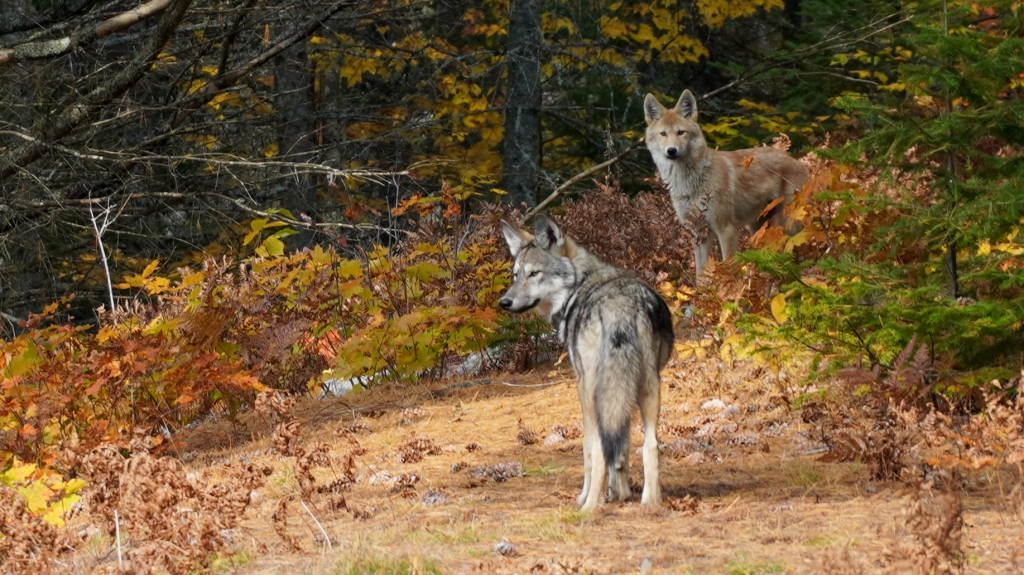|
Getting your Trinity Audio player ready...
|
John Benson shares recent research, conducted alongside colleagues, which monitored the movement of eastern wolves in Algonquin Provincial Park, Canada. Results suggest that eastern wolves and dispersing canids survive poorly outside of APP, primarily due to human-caused mortality. Thus, expanding the threatened population outside of APP is unlikely under current management conditions.
The challenge of human-caused mortality for threatened, hybridizing wolves in Canada
When large carnivores like wolves share landscapes with humans, they are often killed at high rates that limit their abundance. Large parks with relatively undisturbed habitat where intentional killing of large carnivores is prohibited can allow populations to thrive, even if they are rare in adjacent areas.
This is the case for eastern wolves, a threatened species that has persisted within Algonquin Provincial Park in Ontario, Canada, but is rare and patchily distributed outside the park. Complicating the situation, eastern wolves hybridize readily with both smaller eastern coyotes and larger Great Lakes gray wolves within this landscape.
Proposed recovery efforts seek to increase eastern wolves numerically and geographically outside of Algonquin Park, but hybridization, human-caused mortality, and interactions between these processes appear to be major obstacles.
Long-term study in Algonquin region
Despite being listed as threatened, eastern wolves are still shot and trapped legally outside of protected areas. We tracked 438 eastern wolves, Great Lakes wolves, eastern coyotes, and admixed (hybrid) canids from 141 packs with global positioning system (GPS) and traditional telemetry in the Algonquin region from 2002-2020. In our recent study, we used this data to provide
- a comprehensive evaluation of survival
- causes of mortality
- factors influencing mortality risk for wolves, coyotes, and admixed canids.
Eastern wolves are the numerically dominant canid within Algonquin Park where human-caused mortality was relatively low (6% annually). Human-caused mortality from trapping and shooting (24% annually) and vehicle collisions (9% annually) was higher outside of Algonquin, where eastern coyotes and admixed canids are abundant.
To achieve recovery, eastern wolves will need to successfully disperse from the population core in Algonquin to establish breeding territories with other eastern wolves in adjacent areas. However, we found that dispersing canids were killed by humans (52% annually) at more than twice the rate of resident canids (25% annually) outside the park.
Furthermore, resident eastern wolves survived poorly (59% annual survival) relative to resident coyotes and admixed canids (71% annual survival) outside of Algonquin. These results suggest that population expansion of this threatened species outside of Algonquin Park will be challenging under current conditions.
Behaviour influences mortality
Why are eastern wolves more susceptible to mortality outside of Algonquin relative to the other canids? We do not know for sure. A logical explanation is that most eastern wolves in this landscape originate from Algonquin where hunting and trapping are prohibited, leaving them naïve to risk from humans when they disperse into unprotected areas. This suggests that behavioural responses of canids to humans can influence the fate of individual animals – and ultimately the mortality rates in populations.
Indeed, roads are risky features for canids in this landscape as they provide access to hunters and trappers into otherwise remote areas, and also result in mortality from vehicles. We used fine-scale GPS tracking data to evaluate whether individual canids selected or avoided roads – and whether this behaviour influenced their survival.
We found that canids that selected roads, by moving closer to them than expected by chance as they navigated the landscape, were more likely to die. Conversely, canids that actively avoided roads were more likely to survive. While we did not have sufficient data to compare the strength of these behavioural responses between eastern wolves and other canids, we suspect that canids that failed to avoid roads were naïve animals unfamiliar with the risks posed by humans. This fits with the explanation that eastern wolves survive poorly outside of Algonquin because most grew up in the protected area where human risk is much lower.
The road to recovery?
Our work shows that behavioural decisions made by individual canids moving through the risky landscape outside of Algonquin strongly influence population-level mortality rates. For eastern wolves, high rates of mortality appear to limit the abundance and distribution of this threatened species.
Our results will inform managers regarding causes and drivers of mortality as they confront this difficult conservation problem and develop recovery strategies for eastern wolves. Algonquin Park has allowed eastern wolves to persist in Ontario, but it remains to be seen whether they can overcome high rates of hybridization and human-caused mortality to expand successfully throughout the adjacent landscape shared with humans.
Read the full article “Humans drive spatial variation in mortality risk for a threatened wolf population in a Canis hybrid zone” in Journal of Applied Ecology.




